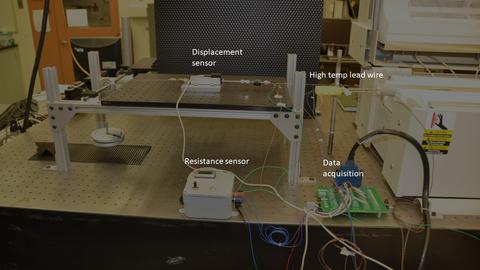Resistance Compensator to Reduce Uncertainty in Determination of Movement of a Structural Member
Patent Number: 10,175,150
Abstract
A new method has been developed for estimating the thermal expansion of an electrically conductive wire that is placed in a high temperature environment with an unknown temperature profile; i.e. a temperature distribution that varies in location and time. The method is based on a simultaneous measurement of the elongation and electrical resistance in the wire. For selected materials, the electrical resistivity and the thermal expansion are nearly linearly dependent on temperature and can be related to each other without specific knowledge of the temperature profile to which the wire is exposed. This method has provided a significant (>90%) reduction in the uncertainty of displacement measurements made with mechanical sensors (e.g. linear potentiometers) through high temperature environments.
Patent Description
The invention is a method of estimating thermal expansion in a "wire" (a long thin flexible element that may be metallic or nonmetallic) by measuring changes in its electrical resistance. In some materials, the electrical resistance and thermal expansion are both almost linearly dependent on the material temperature. Due to this linearity, the relationship between thermal expansion and electrical resistance is not dependent on the particular temperatures to which the wire is subject. These physical properties can be used to greatly improve the measurement accuracy of displacement measurement made in high temperature environments where the changes in the temperature field are unknow; e.g. in a building fire. The new method is limited to temperature · ranges over which the thermal expansion and electrical resistivity of the chosen material are nearly linear with respect to temperature. Of the materials considered in the development of this invention, nickel alloys (e.g. Nichrome 9010) and super alloys (e.g. Hastalloy X®) demonstrated the widest temperature range, and is suitable between 0- and 600-degrees C.

Features
Current practice in the structural fire testing community is to mechanically attach measurement devices which are out of a 'hot zone' to the measurement target which is inside a 'hot zone'. Thermal expansion in the wire or cable used to attach the sensor and target is not considered,but can lead to large measurement uncertainty (e.g. 10 mmlm @ I 000 °C). Under similar conditions, application of this method could reduce this uncertainty to less than 1 mm/m at similar temperatures.

